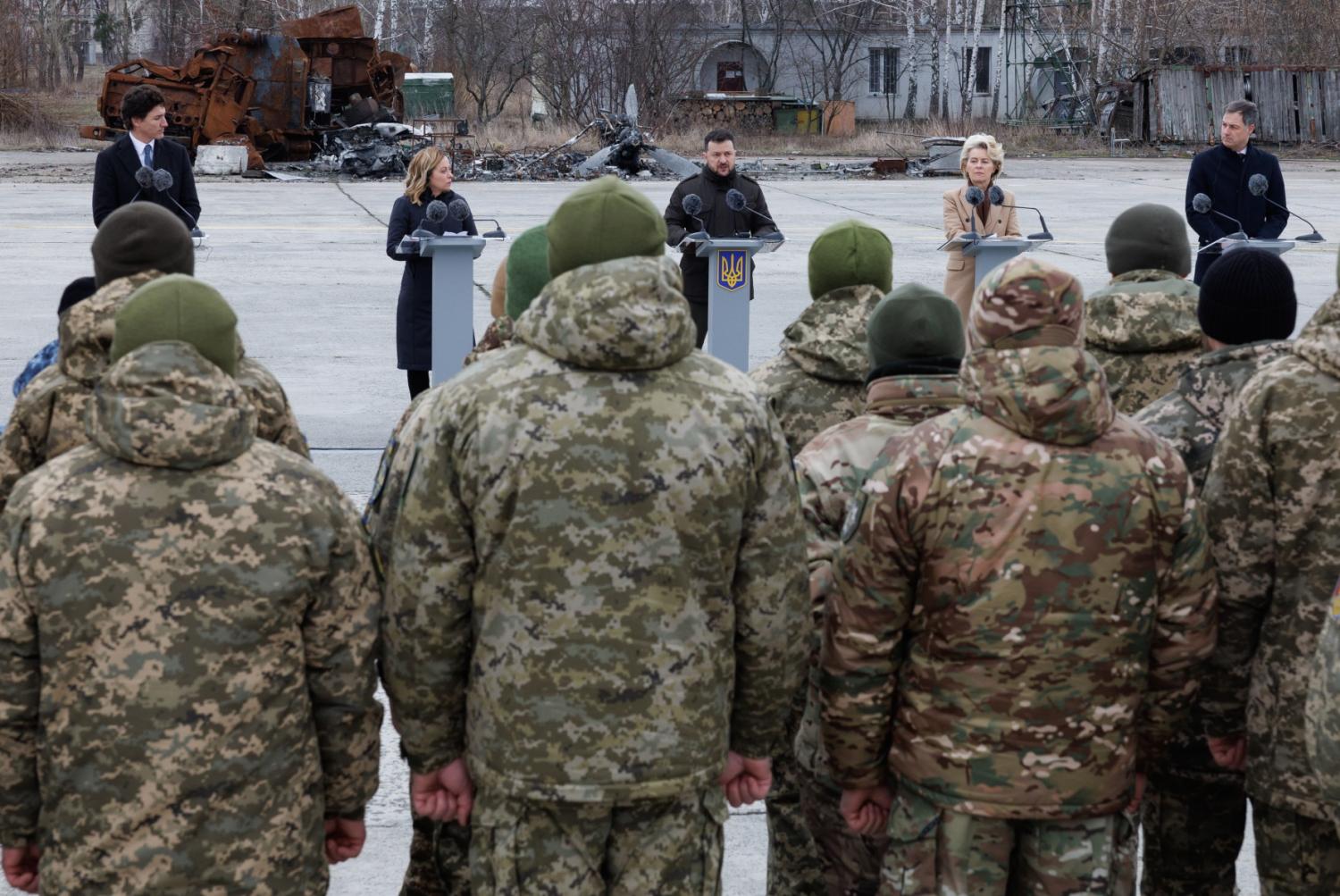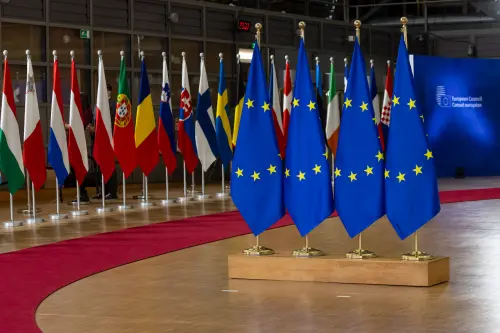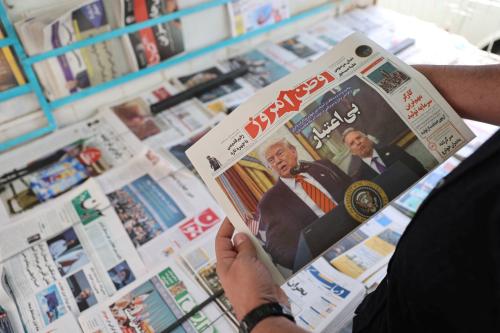NATO has safeguarded U.S. and trans-Atlantic security for 75 years, under Democratic and Republican presidents alike. Could NATO survive a second Donald Trump administration? Most likely not—at least not with the United States as a committed ally and alliance leader. That would pose serious challenges for the European part of the alliance.
Trump’s skepticism about NATO
Trump’s skepticism of allies and alliances dates back well more than three decades. He believes they impose an outsized budgetary burden on the United States, for which it is not “paid.” Further, he believes allies use their defense savings to bolster their industries, out-compete the United States in trade, and take American jobs.
Trump’s views seemed to change little when he assumed the responsibilities of the presidency. At his first NATO meeting in 2017, he complained that allies did not devote 2% of their gross domestic product to defense, a goal NATO leaders had set as a target to meet by 2024 (more than two-thirds of allies will hit that target this year). At a 2018 alliance summit, Trump reportedly asked Secretary of State Mike Pompeo and National Security Advisor John Bolton: “Should we make history here and pull out of NATO?”
Trump did not endorse Article 5 of NATO’s 1949 Washington Treaty, also known as the North Atlantic Treaty, which states that an attack against one “shall be considered an attack against them all.” Reaffirming Article 5 is something American presidents ritualistically do, in part because Article 5 does not commit allies to a specific action. However, American presidents other than Trump made clear the United States would come to the aid of an attacked ally with U.S. military force. That bolsters deterrence.
Trump has signaled something very different. In February, he told a campaign rally that he had warned allies that, if they did not pay up, he would “absolutely not” defend them, adding “I would encourage [the Russians] to do whatever the hell they want.”
Trump does not appear to share other presidents’ view that the United States has a vital national interest in a stable and secure Europe, which NATO helps to ensure. Further, bases in Europe allow the U.S. military to forward-deploy forces closer to hot spots in the Middle East and Africa (United States Africa Command, for example, is headquartered in Germany). And NATO has invoked Article 5 only once in its history: in defense of the United States after 9/11. More than 1,000 NATO troops died in Afghanistan fighting alongside their American comrades. They were there only because they were U.S. allies.
On the other hand, Trump seems to have an affinity for autocrats, and for Russian President Vladimir Putin in particular. He has rarely criticized Putin, whose war on Ukraine has blown up Europe’s security.
The fact that the Trump administration nevertheless bolstered the U.S. military presence in Europe and increased sanctions on Russia should offer little assurances. As president, Trump showed a weak grasp of how the U.S. government works and of how to turn his views into policy. Moreover, advisors such as retired generals John Kelly (White House chief of staff), H.R. McMaster (national security advisor), and Jim Mattis (secretary of defense) worked to soften his worst impulses.
Policy and players in a second Trump administration
Things would almost certainly play out differently in a second term in which Trump’s instinctive skepticism about NATO, affinity for Putin, and disdain for Ukraine would take charge. His campaign website says the United States should “finish the process we began under my Administration of fundamentally reevaluating NATO’s purpose and NATO’s mission.” That is oddly timed when Moscow has launched the bloodiest war in Europe since World War II, and NATO is as important as ever for deterring and containing Russia.
Plans have been developed to translate Trump’s views into policy. The Heritage Foundation’s Project 2025 section on Europe offers three visions for dealing with Russia1, two of which would appear to lessen the U.S. commitment to NATO, and leaves it to the president to decide. Trump almost certainly would choose one of those two.
A briefing paper that reportedly got attention in Trump’s inner circle argued that the United States should adopt a “dormant NATO” policy. That would mean shifting the primary defense burden to European allies while America served as an offshore “balancer of last resort.” That diminution of the U.S. role in NATO appears to mesh well with Trump’s thinking.
Lists are being prepared of potential officials to implement those policies. The lists will not include the likes of Kelly, McMaster, and Mattis, but people such as Richard Grenell and Elbridge Colby. Grenell, who served as Trump’s ambassador to Germany, has been described as transactional and isolationist; in 2020, he pushed for a drawdown of U.S. troops in Germany because the Germans had not met the 2% defense spending target, a target that NATO had agreed should be met by 2024 (and which Germany hit this year). Colby argues for a China-first policy that would leave little room for the U.S. commitment to NATO.
Moreover, today’s Republican Party is no longer the party of Ronald Reagan and John McCain. While some Republican senators and members of Congress support a strong U.S. presence in NATO, few have shown any readiness to challenge Trump, who has firmly locked down his position as GOP leader. In fact, quite the opposite. Senate Minority Leader Mitch McConnell, who has consistently supported NATO and Ukraine, recently penned an op-ed entitled “We Cannot Repeat the Mistakes of the 1930s.” However, he has endorsed Trump, whose America First views echo precisely those mistakes. In any case, McConnell will step down from his leadership position in November.
Bolton has flatly predicted: “In a second Trump term, we’d almost certainly withdraw from NATO.” The 2024 National Defense Authorization Act includes a provision requiring two-thirds Senate approval for a decision to leave NATO. However, it is not clear that would survive a legal challenge. Even if Trump did not formally withdraw, he could draw down U.S. forces in Europe and, if it came to it, simply ignore Article 5.
Views of NATO allies in Europe
Allied leaders already have reason to doubt Trump’s commitment to the alliance. If Trump wins in November and Putin shares that doubt, the security risk for Europe would grow significantly.
NATO leaders understandably view the prospect of Trump’s return with trepidation and privately talk of “Trump-proofing” the alliance while considering ways to persuade the former president of NATO’s value. That trepidation is a factor that has helped boost defense spending by European NATO members—as a way to demonstrate that Europe is taking on a greater share of the burden but also as a hedge against a Trump decision to downgrade the U.S. commitment to the alliance. Some European officials have reached out to Trump; those efforts have not had an evident effect.
Were Trump to win in November and then reduce the U.S. commitment, a number of challenges would confront European NATO members. First, Ukraine. Trump recently reiterated that he would end U.S. support. That would mean a greater financial burden on Europe, but Europe alone lacks the defense industrial capacity to meet Ukraine’s needs, at least in the near term.
Second, Russia. NATO’s European members collectively have an economy many times larger than Russia’s. They would need time, however, to turn that into hard military power and would face a particular struggle making up for enablers now provided by the U.S. military, such as intelligence, surveillance, and reconnaissance assets; heavy airlift; and long-range strike capabilities such as conventionally-armed air- and sea-launched cruise missiles.
Third, the nuclear dimension. Were Trump to fold the nuclear umbrella the United States extends over NATO, could the nuclear forces of Britain and France suffice to protect all European members of the alliance? The possible end of the American extended deterrent has even prompted a discussion in Berlin about a German need for nuclear arms.
Fourth, NATO leadership on major questions traditionally has come from Washington. If the United States under Trump were to withdraw, as Bolton predicted, or just dramatically cut back its role, who would take up the leadership mantle?
European members of the alliance must further build their militaries and continue to take on a greater share of the defense burden for Europe, particularly as the United States has to deal with a rising China in the Indo-Pacific region. That shift is already well underway: non-U.S. members of NATO (European members plus Canada) accounted for about 27% of total NATO member defense spending in 2014; in 2024, that figure had risen to about 36%. The problem is that even that kind of increase likely would not prove enough for Trump—who has suggested that allies devote 4% of GDP to defense—and that, if reelected, he would move abruptly to scale back the U.S. role in the alliance. NATO absent a strong U.S. commitment in a second Trump administration would be a very different—and considerably weaker—organization.
There is a small chance that Trump, who often seems uninterested in specific policies, might leave NATO alone. Even in that event, however, could Europe count on the mercurial and unpredictable former president when the chips were down? It would not appear to be a good bet.
-
Footnotes
- See page 182 for more details.
The Brookings Institution is committed to quality, independence, and impact.
We are supported by a diverse array of funders. In line with our values and policies, each Brookings publication represents the sole views of its author(s).






Commentary
Could NATO survive a second Trump administration?
June 25, 2024